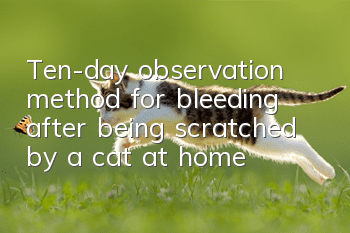Ten-day observation method for bleeding after being scratched by a cat at home

Nowadays, many people keep pets and regard them as friends or relatives. They always hold dogs or cats in their arms or play with them. In the process of playing with pets, they will inevitably be attracted by them. If the claw is scratched, is the ten-day observation method circulated on the Internet for scratches and bleeding by cats effective? Today we are going to do some popular science.
What is the ten-day observation method
The ten-day observation method was born in the 1990s and was proposed by a Thai scientist. Currently, the World Health Organization recommends it in Europe, America, and Implemented by Japan and other countries and regions. It is one of the rabies prevention and control methods recommended by the World Health Organization (details). It means that after being bitten or scratched by a dog or cat, the animal should be kept and observed for ten days (in rabies endemic areas, vaccination needs to be injected first and then observed). If the bite is If no human animal dies within 10 days, it proves that although the biting animal may still be a carrier of rabies virus, the animal must not be contagious with rabies virus (rabies is only contagious during the onset of the disease and 2-3 days before the onset of the disease) , virus carriers are not contagious), and the person bitten can 100% rule out the possibility of transmitting rabies.
Of course, the ten-day observation method is not applicable to all areas. Three conditions must be met:
1. No human rabies occurs;
2 . Animals raised by humans are not responsible for the occurrence of human rabies, that is, the source of rabies virus transmission comes from wild animals;
3. The injured must be vaccinated with a modern cell-cultured, qualified human rabies vaccine at the same time.
And the ten-day observation method itself also has requirements. It does not mean that you do nothing after the injury and wait ten days before dealing with it. First of all, the dog or cat that injures people must have had more than two reliable animal rabies immunization histories, the vaccine must be compliant and traceable, and the veterinarian and hospital administering the injection must be qualified. Under this premise, injured animals can be sent to professional veterinary stations for ten days of medical observation, including laboratory testing. But at the same time, the injured should receive immediate wound treatment and rabies vaccination. If the animal is still healthy after ten days and the test results are normal, the remaining injections can be dispensed with.
- A cat will die if it urinates for a few days
- Should you deworm yourself or go to a pet store?
- Are cat teasers harmful to cats?
- What should I do if my cat suffers from chronic gingivitis?
- Cat's nails are cracked with a thin layer
- Cats go crazy after eating mutton
- What does cat moss on a cat’s chin look like?
- Can cats reproduce after abdominal transmission is cured?
- What exactly is the sterilization shot for female cats?
- Can I still eat unopened cat food if it has expired?



